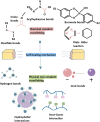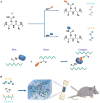Self-healing hydrogels for bone defect repair
- PMID: 37283866
- PMCID: PMC10240173
- DOI: 10.1039/d3ra01700a
Self-healing hydrogels for bone defect repair
Abstract
Severe bone defects can be caused by various factors, such as tumor resection, severe trauma, and infection. However, bone regeneration capacity is limited up to a critical-size defect, and further intervention is required. Currently, the most common clinical method to repair bone defects is bone grafting, where autografts are the "gold standard." However, the disadvantages of autografts, including inflammation, secondary trauma and chronic disease, limit their application. Bone tissue engineering (BTE) is an attractive strategy for repairing bone defects and has been widely researched. In particular, hydrogels with a three-dimensional network can be used as scaffolds for BTE owing to their hydrophilicity, biocompatibility, and large porosity. Self-healing hydrogels respond rapidly, autonomously, and repeatedly to induced damage and can maintain their original properties (i.e., mechanical properties, fluidity, and biocompatibility) following self-healing. This review focuses on self-healing hydrogels and their applications in bone defect repair. Moreover, we discussed the recent progress in this research field. Despite the significant existing research achievements, there are still challenges that need to be addressed to promote clinical research of self-healing hydrogels in bone defect repair and increase the market penetration.
This journal is © The Royal Society of Chemistry.
Conflict of interest statement
There is no conflict of interest for all the authors.
Figures





Similar articles
-
GelMA-based bioactive hydrogel scaffolds with multiple bone defect repair functions: therapeutic strategies and recent advances.Biomater Res. 2023 Sep 15;27(1):86. doi: 10.1186/s40824-023-00422-6. Biomater Res. 2023. PMID: 37715230 Free PMC article. Review.
-
Hydrogel scaffolds in bone regeneration: Their promising roles in angiogenesis.Front Pharmacol. 2023 Feb 13;14:1050954. doi: 10.3389/fphar.2023.1050954. eCollection 2023. Front Pharmacol. 2023. PMID: 36860296 Free PMC article. Review.
-
Application of gelatin-based composites in bone tissue engineering.Heliyon. 2024 Aug 14;10(16):e36258. doi: 10.1016/j.heliyon.2024.e36258. eCollection 2024 Aug 30. Heliyon. 2024. PMID: 39224337 Free PMC article. Review.
-
Role of Hydrogels in Bone Tissue Engineering: How Properties Shape Regeneration.J Biomed Nanotechnol. 2020 Dec 1;16(12):1667-1686. doi: 10.1166/jbn.2020.2997. J Biomed Nanotechnol. 2020. PMID: 33485397 Review.
-
Bioactive hydrogels for bone regeneration.Bioact Mater. 2018 May 26;3(4):401-417. doi: 10.1016/j.bioactmat.2018.05.006. eCollection 2018 Dec. Bioact Mater. 2018. PMID: 30003179 Free PMC article. Review.
Cited by
-
Fibronectin Functionalization: A Way to Enhance Dynamic Cell Culture on Alginate/Hydroxyapatite Scaffolds.J Funct Biomater. 2024 Aug 10;15(8):222. doi: 10.3390/jfb15080222. J Funct Biomater. 2024. PMID: 39194660 Free PMC article.
-
Design of a double-layered material as a long-acting moisturizing hydrogel-elastomer and its application in the field protection of elephant ivories excavated from the Sanxingdui Ruins.RSC Adv. 2024 Aug 8;14(34):24845-24855. doi: 10.1039/d4ra03919j. eCollection 2024 Aug 5. RSC Adv. 2024. PMID: 39119283 Free PMC article.
-
T. gondii excretory proteins promote the osteogenic differentiation of human bone mesenchymal stem cells via the BMP/Smad signaling pathway.J Orthop Surg Res. 2024 Jul 1;19(1):386. doi: 10.1186/s13018-024-04839-0. J Orthop Surg Res. 2024. PMID: 38951811 Free PMC article.
-
Advancing Dentistry through Bioprinting: Personalization of Oral Tissues.J Funct Biomater. 2023 Oct 20;14(10):530. doi: 10.3390/jfb14100530. J Funct Biomater. 2023. PMID: 37888196 Free PMC article. Review.
-
Poly(methyl methacrylate) in Orthopedics: Strategies, Challenges, and Prospects in Bone Tissue Engineering.Polymers (Basel). 2024 Jan 29;16(3):367. doi: 10.3390/polym16030367. Polymers (Basel). 2024. PMID: 38337256 Free PMC article. Review.
References
-
- Klenke F. M. and Siebenrock K. A., in Reference Module in Biomedical Sciences, Elsevier, 2016, 10.1016/B978-0-12-801238-3.99488-1 - DOI
-
- El-Rashidy A. A. Roether J. A. Harhaus L. Kneser U. Boccaccini A. R. Acta Biomater. 2017;62:1–28. - PubMed
-
- Li C. Sun J. Shi K. Long J. Li L. Lai Y. Qin L. J. Mater. Chem. B. 2020;8:4575–4586. - PubMed
-
- Mancuso E. Shah L. Jindal S. Serenelli C. Tsikriteas Z. M. Khanbareh H. Tirella A. Mater. Sci. Eng., C. 2021;126:112192. - PubMed
Publication types
LinkOut - more resources
Full Text Sources

